Lecture
Это продолжение увлекательной статьи про теория обучения.
...
данному учебному предмету, а также последовательность изучения тем и время, отводимое на их изучение. Учебные программы подразделяются на типовые и рабочие. Типовые программы утверждаются Министерством образования и имеют рекомендательный характер. Рабочие – те, по которым фактически работает школа. Рабочие программы разрабатываются на основе типовых программ и образовательного стандарта; они утверждаются педагогическим советом школы.
Учебные программы состоят из следующих основных элементов:
- пояснительной записки, в которой определяются основные цели и задачи учебного предмета, его воспитательные и развивающие возможности, а также главные идеи, лежащие в основе его построения;
- содержания образования (тематический план с указанием часов, отводимых на каждую тему, а также содержание изучаемых тем);
Кроме того, в образовательной программе обычно даются некоторые методические указания по реализации учебной программы.
К учебной литературе относятся учебники, учебные пособия и учебно-методические пособия. В учебной литературе содержание образования раскрывается наиболее подробно, а также содержатся рекомендации и дидактические средства, обеспечивающие его усвоение.
Учебник – это основная учебная книга по конкретной дисциплине, в которой излагается система базовых знаний в соответствии с требованиями государственного образовательного стандарта, с учётом особенностей возрастного развития детей и особенностей методики преподавания данного предмета в школе. Содержание учебника должно полностью раскрывать типовую программу, а его название – соответствовать названию предмета.
Учебное пособие – учебная книга, являющаяся дополнением к учебнику. В отличие от учебника, учебное пособие может охватывать не всю дисциплину, а лишь её часть, включать не только общепризнанные знания и положения, но и пока не подтверждённые гипотезы, различные мнения. К учебным пособиям относятся хрестоматии, сборники задач и упражнений, атласы и т.п.
Учебно-методическое пособие – учебное издание по методике преподавания какой-либо дисциплины или её части. Эта учебная литература адресована учителям.
To the top
Многообразие образовательных программ
Образовательные программы, по которым ведётся обучение, очень разнообразны. Существует несколько оснований, для разделения программ на типы и виды.
Все программы можно разделить на два типа: программы общего образования и программы профессионального образования . Внутри каждого типа программы подразделяются на виды по ступеням обучения.
Программы общего образования делятся на…
- программы дошкольного образования;
- программы начального образования;
- программы основного образования;
- программы полного (среднего) образования;
- программы дополнительного образования.
Среди программ профессионального образования выделяются…
- программы начального профессионального образования;
- программы среднего профессионального образования;
- программы высшего профессионального образования;
- программы послевузовского профессионального образования;
- программы дополнительного профессионального образования.
Учебные программы, рассчитанные на детей школьного возраста, подразделяются на типовые (примерные) и рабочие . Типовые программы утверждаются Министерством образования и имеют рекомендательный характер. Рабочие – те, по которым фактически работает школа. Рабочие программы разрабатываются на основе типовых программ и образовательного стандарта; они утверждаются педагогическим советом школы.
Выделяются также модифицированные (адаптированные) образовательные программы, по содержанию и логике совпадающие с типовыми (примерными), но составленные с учётом конкретных условий их реализации.
Образовательные программы подразделяются также на основные и программы дополнительного образования (программы курсов по выбору, факультативов, кружков и т.д.).
В свою очередь, программы дополнительного образования по уровню освоения могут быть общеразвивающими, специализированными или профессионально ориентированными. Общеразвивающие образовательные программы направлены на решение задач формирования общей культуры ребенка, расширения его социального опыта, знаний о мире и о себе. Специализированные программы направлены на выявление и развитие способностей детей, формирование знаний и умений в определённом виде деятельности. Профессионально ориентированные помогают детям определиться в выборе профессии.
Особую группу образовательных программ составляют авторские программы. Авторские программы учитывают требования образовательного стандарта, однако могут содержать иную логику построения учебного материала, быть направлены не прикладное использование изучаемых наук, носить интегративный, межпредметный характер (объединять, связывать несколько учебных предметов). Чаще всего авторские программы создаются для факультативных курсов или предметов обязательных по выбору. Авторские программы утверждаются педагогическим советом школы и (или) программно-экспертным советом при педагогическом вузе, управлении образования.
Выделяются также экспериментальные образовательные программы, особенностью которых является направленность на изменения, привносимые в цели, содержание и организацию учебного процесса. Экспериментальные программы способствуют проверке научных гипотез, выбору наиболее продуктивных инновационных идей, внедрению новых форм и методов обучения.
Ещё один вид образовательных программ – программы дистанционного образования , отражающие специфику этого способа организации учебного процесса.
Некоторые образовательные программы носят междисциплинарный характер. Среди них можно выделить следующие виды:
- комплексные - объединяющие отдельные области, направления, виды деятельности;
- Integrated - study-oriented students of several industries united by a common idea, a common property (for example, a poly-artistic program);
- modular - consisting of several independent units; Each block has integrity, stability, the composition and sequence of blocks in the program may vary.
Educational programs may vary according to the structured presentation of the educational material. There are three main structural methods: linear, concentric and spiral (Fig. 4.3).
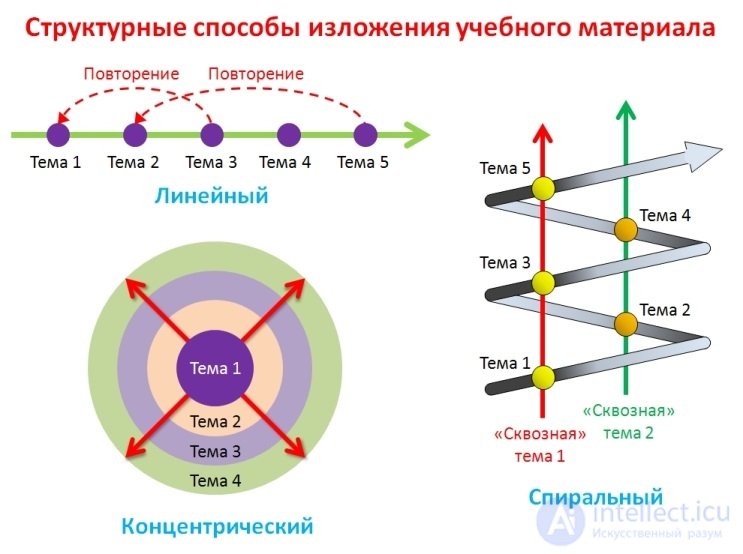
Fig. 4.3. Structural methods of presentation of educational material
With the linear method, the material is studied sequentially: from section to section, from topic to topic. Appeal to the previous material is carried out sporadically, as a repetition of the studied to ensure the strength of training or to prepare for the assimilation of a new material.
In the concentric presentation of the educational material, the material of this stage of education is studied in a complicated form at the following stages. In fig. 4. it is shown that the material of each previous topic is included in the next. In this case, topic 1 can be studied, for example, in grade 5, topic 2 - in the 6th, topic 3 - in the 7th, and topic 4 - in the 8th.
The peculiarity of the spiral method of presenting the material in the educational program is that with the sequential study of the material, key ideas, questions, problems (in the figure, “cross-cutting” topics) are highlighted, which are revealed in the study of various topics, gradually becoming more complex at each new turn of the spiral.
Sometimes, as another way of structuring educational material, an extensive method is highlighted. The essence of this method is that in order to achieve the educational goal, several alternative ways are provided. Thus, an extensive program implies that the student chooses his or her own individual way of mastering holistic educational information. Extensive programs are used in training, focused on the independent search for knowledge of students under the guidance of a teacher-consultant (for example, in programmed or distance learning).
To the top
Methods and techniques of learning
The teaching method (from the Greek. Methodos - “the way, the way to achieve the goal”) is a system of consecutive interconnected actions of the teacher and students, ensuring the assimilation of educational material.
Method - a multidimensional and multidimensional concept. Each teaching method has many properties and attributes, as a result of which there are many principles of their differentiation. Therefore, in pedagogical science there is no single approach to the selection of teaching methods.
Different authors distinguish the following teaching methods: story, explanation, conversation, lecture, discussion, work with a book, demonstration, illustration, video method, exercise, laboratory method, practical method, test, survey (variations: oral and written, individual, frontal , compacted), programmed control method, test control, essay, didactic game, etc. This list is far from complete.
In the process of learning, the teacher uses various methods: story, work with a book, exercise, demonstration, laboratory method, etc. It is important to remember that no one method is universal, i.e., a single method will not give the required results in full . Good results in training can be achieved only when using a number of methods that complement each other.
The effectiveness of teaching methods in a particular pedagogical situation depends on the specific goals and objectives of the training. The most important component of pedagogical competence is the ability of the teacher to choose and apply teaching methods correctly.
The choice of teaching methods is due to a number of factors, including:
- goals of education, upbringing and development of students;
- features of the content of the studied material;
- particular methods of teaching a particular school subject;
- the time allotted for the study of a material;
- the level of preparedness of students, their age characteristics;
- the level of pedagogical skills of the teacher;
- material and technical conditions of training.
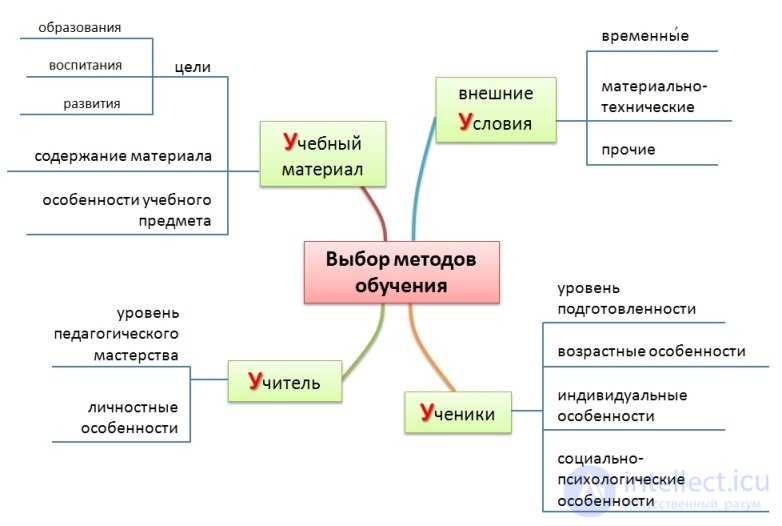
Fig. 4.4. Selection of teaching methods
Training methods in work practice are realized with the help of methods and means of training, i.e. the method in its specific embodiment is a combination of certain techniques and means.
Teaching techniques (didactic techniques) are usually defined as elements of methods, individual actions as part of a general teaching method. Admission is not a method yet, but its integral part, but the practical implementation of the method is achieved precisely with the help of techniques. So, in the method of working with a book, the following techniques can be distinguished: 1) reading aloud; 2) drawing up a text plan; 3) filling in the table on the material read; 4) drawing up a logical scheme of reading; 5) note taking; 6) selection of quotes, etc.
Acceptance of training can be considered as a separate step in the practical application of the method. The sequence of these steps in the process of implementing the method leads to the goal of learning.
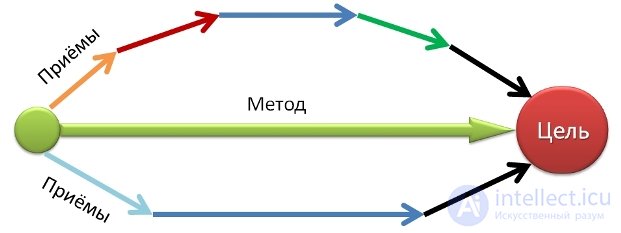
Fig. 4.5. The ratio of reception and method
The same method in various situations can be carried out using different techniques. For example, working with a book in one case may include reading out loud and drawing up a plan of the text, in another case, drawing up a logical scheme and selecting quotes, and in the third case taking notes.
The same technique can be part of different methods. So, drawing up a logical scheme can be part of an explanatory and illustrative method (for example, a teacher explaining a new material, drawing a scheme on a blackboard), and can also be used as part of a research method (for example, students make a diagram reflecting the material they independently study).
Teaching methods are developed in the experience of many teachers and improved over decades. Many of the modern methods appeared many centuries ago. For example, the story and the exercise were already known in the schools of the Ancient World, and in Ancient Greece, Socrates improved the method of conversation and began to use it to develop thinking and enhance the cognitive interest of students. Unlike methods, techniques can be created in the experience of an individual teacher, determining the uniqueness of his individual pedagogical style.
There are relatively few methods, there are countless methods, therefore it is very difficult to classify methods and it is almost impossible to compile a complete, exhaustive list of all didactic methods. In fig. 4.6. Only some groups of learning techniques are presented.
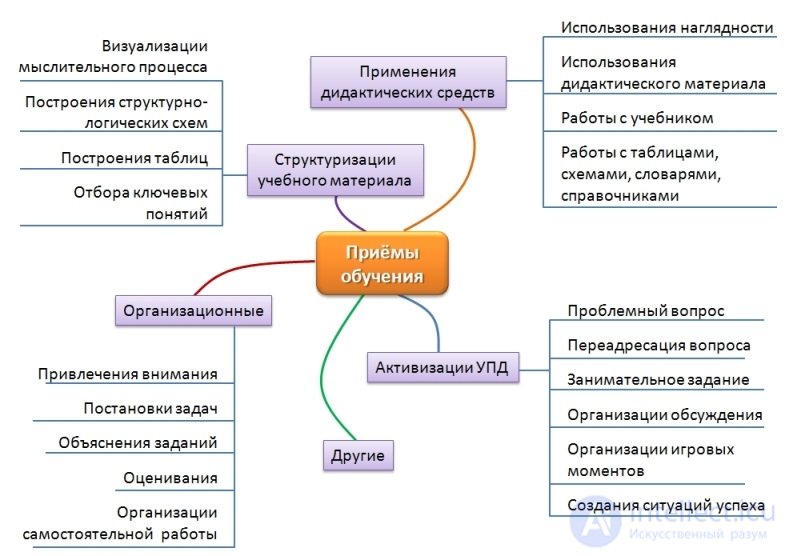
Fig. 4.6. Types of learning techniques
To the top
Classification of teaching methods
The classification of teaching methods is complicated by the multidimensionality of the notion “teaching method”, the ambiguity of interpretations of various methods, and the difference in approaches to understanding the learning process. Today there are quite a lot of classifications of teaching methods, but none of the existing classifications is generally accepted. The most common are classifications according to the source of study (E.I. Perovsky, D.O. Lordkipanidze), according to the nature of students' cognitive activity (I.Ya. Lerner, M.N. Skatkin), and also the polynar (by several criteria) classification Yu. TO. Babansky.
In the classification of methods according to the source of training , three groups of teaching methods are distinguished:
1) verbal (the source of training is the word, speech): story, conversation, lecture, work with the book;
2) visual (the source of training is visual means demonstrated by the teacher): demonstration of experiments, natural objects, samples of activity, etc .;
3) practical (the source of training is practical activity): practical and laboratory work, exercise, problem solving, object modeling.
The classification of teaching methods according to the nature of students' cognitive activity includes the following methods:
1) explanatory and illustrative (information-receptive) ; the essence of this method lies in the fact that the teacher explains, organizes the perception of educational material in various ways, and students perceive, comprehend, memorize;
2) reproductive : the teacher explains, and the students comprehend, memorize, reproduce, repeat the teaching material many times;
3) problem presentation method : the teacher explains the educational material as a solution to the problem: he himself puts the problem and solves it; students follow the actions and the train of thought of the teacher, get a sample of the reasoning for self-solving problems;
4) partial-search (heuristic) : the teacher explains and organizes the search for new knowledge, students independently reason, solve cognitive tasks under the guidance of the teacher;
5) research : the teacher formulates the problem (sometimes with the students), in the process of solving the problem helps only in difficult cases or monitors the activities of students, recording their successes and failures; students solve the problem on their own.

Fig. 4.7. Classification of teaching methods according to the nature of educational and cognitive activity
It is easy to see that the methods are arranged in order of increasing independence and activity of students: when using the first two methods, knowledge is presented to the student as a finished product. The last two suggest that knowledge is acquired by the student independently. The method of problem presentation in this sense can be considered as a transitional one, preparing students for independent cognitive actions.
In the classification of Yu.K. Babansky teaching methods are divided into ...
1) methods of organizing and implementing educational activities:
- by source of learning: verbal, visual, practical;
- according to the logic of learning: inductive (learning is built from particular facts to the identification of general rules and patterns) and deductive (from general laws and rules to recognition and explanation of particular cases of these laws and rules);
- in thinking: reproductive (reproducing, based on memorizing educational material) and problem-searching (associated with the acquisition of knowledge by the student himself);
- on management: methods of work under the guidance of a teacher and methods of independent work of students;
2) methods of stimulation and motivation of educational and cognitive activity:
- methods of stimulating and motivating interest in learning;
- methods of stimulating and motivating debt and responsibility in teaching;
3) methods of control and self-control:
- methods of oral control and self-control: frontal or individual interview, student's story, reading the text, explanation of the scheme, etc .;
- methods of written control and self-control: examination, abstract, presentation, composition, dictation, etc .;
- laboratory and practical (practical and laboratory work) and machine (with the help of special equipment, for example, performing a test on a computer) control and self-control.
To the top
Means of education
Practical application of teaching methods and techniques is possible only with the necessary funds. So, to work with a book, a book is needed, for a laboratory method, appropriate laboratory equipment, etc.
Teaching tools are the substantive support of the educational process: material and materialized objects used as tools of the teacher’s activities, as well as information carriers in the educational process. Tangible textbooks include textbooks, visual aids (illustrations, dummies, stuffed animals, mineral collections, etc.), didactic material, technical teaching aids (TCO), and other equipment used in training. Materialized means are speech, facial expressions and gestures, as well as various activities (labor, cognitive, communicative, etc.)
Material teaching aids are otherwise called didactic means . Didactic means are most often classified according to sensory modality (depending on which sense organs and methods of presenting information their influence on the learning process occurs). On this basis, didactic tools can be divided into visual, audio, audiovisual, simulators and universal.
Material teaching aids are otherwise called didactic means . Didactic means are most often classified according to sensory modality (depending on which sense organs and methods of presenting information their influence on the learning process occurs). On this basis, didactic tools can be divided into visual, audio, audiovisual, simulators and universal.
The following means of transmitting visual information include visual didactic tools:
- printed text means: textbooks and manuals, printed workbooks, dictionaries, reference books;
- simple visual means: natural objects, models, models, models, reproductions, tables, charts, diagrams, maps, etc .;
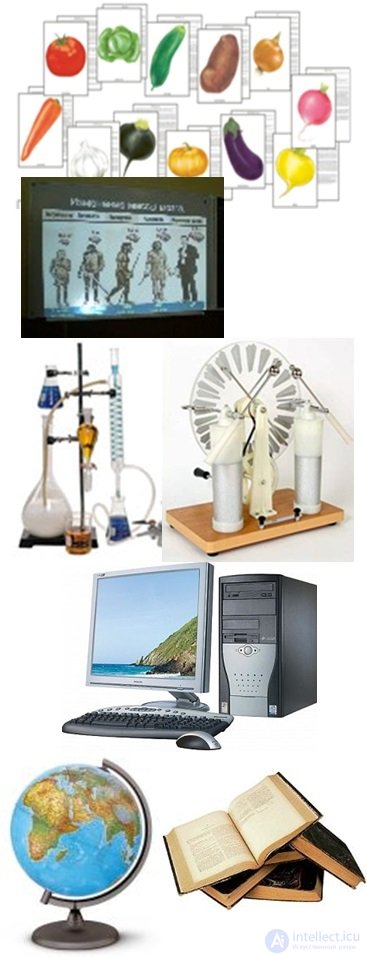
Fig. 4.8. Examples of didactic tools
- technical (mechanical) visual aids: a microscope, a telescope, various types of projectors, a video player, an interactive whiteboard, as well as information carriers used with them (optical disks, slides, transparencies, etc.) and multimedia electronic means (for example, slide presentations);
Audio means are means of transmitting sound information: recording and reproducing sound equipment, various types of players (tape recorder, CD player, etc.), radio receiver.
Audiovisual tools combine the ability to transfer sound and visual information. These include cinema, television and video and web cameras, broadcasting and reproducing equipment (television, movie camera, video and DVD players, etc.), multimedia electronic means (video tutorials and video used in the educational process).
Simulators are didactic tools that create conditions for the most efficient practice of practical actions, the formation of skills and abilities. As a rule, simulators are focused on a specific academic subject, on mastering individual skills. Modern simulators are technical means that have become widely used in Russian schools relatively recently. This group of didactic tools includes, for example, language equipment, computer simulators. However, in the educational process, simple (non-technical) simulators have been used for a long time, among which various cards or exercise books have received the greatest distribution.
Universal didactic tools are computer and network information systems (local computer networks and the global Internet). With the ability to connect various equipment and a variety of installed programs, today a computer can be used as a visual, audio or audiovisual tool, as well as a simulator. The compact size of modern computers (laptop, netbook, tablet computer), their reliability and compatibility with other technical means make the computer a convenient and effective learning tool. The use of the Internet in the educational process virtually removes the territorial limitations of access to information, allowing you to use the resources of the largest electronic libraries and educational portals, to organize distance learning at a qualitatively new level.
Along with the above-described approach to the classification of didactic means in educational practice, traditionally stand out ...
- technical training aids (TSS) ;
- educational visual aids (these include non-textual visual aids: natural objects, their images, models, models, models, etc.);
- Handout - compact didactic tools designed for individual use by the student (for example: a collection of minerals, herbariums; a set of parts for making a drawing or a technical drawing; cards with individual tasks);
- didactic material - cards with tasks for individual work, collections of exercises, etc .;
- educational and laboratory equipment - equipment of educational laboratories for the study of natural sciences (physics, chemistry, biology);
- teaching and production equipment - equipment training workshops, which differs from the usual production in that it is made specifically for training purposes, it is more compact, safe and not intended for mass production.
Functions of learning tools due to their didactic properties. In the educational process learning tools perform four main functions:
- compensatory (learning tools facilitate the learning process, help to achieve the goal with the least effort and time);
- adaptive (teaching tools help the teacher adapt the content of education to the age and individual abilities of children, create favorable conditions for learning: help organize the necessary demonstrations, independent work of students, differentiate learning tasks, etc.);
- informative (teaching aids are either a direct source of information (a textbook, a training video, etc.), or contribute to the transfer of information (blackboard, projection equipment, laboratory equipment, etc.);
- integrative (the use of learning tools makes it possible to consider the studied subjects and phenomena in many ways, to identify and observe the various properties of the subject, to penetrate deeper into its essence, for example, when studying a law of physics, the use of teaching and laboratory equipment allows observing the effect of this law, understanding its meaning and etc.).
To the top
Forms of study
The form of education is a way of organizing the educational process based on the interaction of methods, techniques and means of training. The form reflects the external side of the organization of the educational process. The form contributes to the realization of not one goal (as a method), but a complex of didactic goals.
In the theory and practice of education, there are many different forms of education: full-time and part-time, distance, school and out-of-school, individual and mass education, family education, etc.
Among the forms of organization of the educational process are highlighted forms of training . These include a lesson, lecture, seminar, laboratory work, excursion, elective, etc. On races. 4.9 shows an example of the implementation of methods, techniques and teaching aids at lectures.
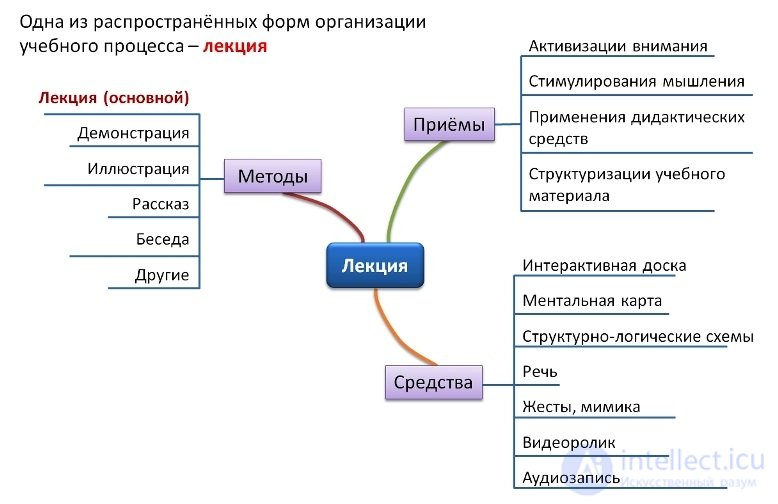
Fig. 4.9. Methods, techniques and means of teaching at the lecture
To the top
Урок как основная форма обучения в современной школе
Формы учебных занятий подразделяются на основные и дополнительные. В школе основной формой обучения является урок, в вузе - лекция и семинар.
Урок – основная структурная единица учебного процесса в современной школе. Он характеризуется следующими признаками:
а) постоянным составом педагогов, работающих с данным классом;
б) предметной системой обучения (на уроке изучается определённый учебный предмет);
в) относительной структурной завершённостью (урок представляет собой законченный отрезок преподавания и учения, в его структуре легко выделяются начало и конец).
К современному уроку предъявляется много требований. К общим требованиям относятся:
- реализация на каждом уроке основных функций обучения: образовательной, воспитательной, развивающей;
- использование на уроке новейших достижений науки и передовой педагогической практики;
- построение урока на основе закономерностей учебно-воспитательного процесса;
- реализация на уроке принципов обучения в их оптимальном соотношении;
- motivation and activation of all areas of students' personality;
- the relationship of the material under study with the previously studied, reliance on this level of development of students;
- establishment of interdisciplinary connections in the classroom;
- providing conditions for productive activity of students, taking into account their interests, inclinations, needs, abilities;
- the logic of all stages of the lesson and emotionality;
- effective use of material and materialized teaching aids;
- the relationship of educational material and work in the classroom with life, with the personal experience of students, with production activities;
- the formation of children's ability to learn, learning their rational methods of thinking and activity;
- formation of the need for children to constantly replenish the volume of knowledge, acquire new skills and abilities; formation of the need for self-development;
- diagnostics, prediction, careful lesson planning.
One of the general requirements for a lesson is the presence of a triple didactic goal (TCD), including educational, educational and developmental tasks that are correlated with the main functions of learning.
The implementation of all three functions of learning in each lesson is achieved by observing a set of requirements that reflect the educational, educational and developmental functions.
Educational requirements include:
- a clear definition of the educational objectives of each lesson;
- rational selection of information for the lesson, optimization of the content of education, taking into account the personal and age characteristics of students;
- a rational combination of various forms and methods of education;
- a creative approach to planning the structure of the lesson;
- a combination of individual, group and collective forms of education;
- providing feedback on the lesson, control of learning material mastering, pedagogical management of students' learning and cognitive activity;
- use of new achievements of pedagogical science and new educational technologies.
The educational requirements for the lesson include:
- determination of educational opportunities of educational material and organization of students' activities;
- statement of educational tasks, really achievable, logically following from the goals and content of this lesson;
- the formation of vital qualities: discipline, responsibility, accuracy, independence, collectivism, perseverance, etc .;
- attentive and sensitive attitude to students, pedagogical tact, cooperation with students and interest in their success.
Developmental requirements include:
- the formation and development of students positive motives of educational and cognitive activity, interests, activity and creative initiative;
- development of attention, memory, thinking, feelings and emotions;
- the study and consideration of the individual characteristics of students, the promotion of new qualitative changes in their development.
In addition to the general requirements for the lesson, there are psychological, organizational, managerial, sanitary and other requirements.
Each lesson takes a certain place in the system of teaching this subject in a given class in this variant of the curriculum. In other words, the value of a single lesson in the educational process is relatively small if it is “torn out” from the general system of studies. Learning lesson material occurs not only in the classroom, but also in the process of student homework, as well as during consolidation and synthesis in subsequent classes.
To the top
Typology and structure of lessons
Lessons can be classified according to goals, methods, means of learning, etc. The classification of I.N. Kazantsev and B.P. Esipova on goals and place in the general system of lessons. According to this classification, there are six types of lesson :
1) the lessons of familiarization with the new material;
2) the lessons of consolidation of the studied;
3) lessons of generalization and systematization;
4) the lessons of the formation of skills;
5) control lessons (examination of knowledge and skills);
6) combined lessons (including elements of the previous types).
The structure of a lesson is a certain sequence of its stages, each of which is distinguished by the nature of the tasks to be solved, the peculiarities of the activity of the teacher and the students, and emotional mood.
Some stages may be present at all lessons (stages of communication of the topic and tasks of the lesson, learning motivation, homework explanations, summing up), other stages reflect the specifics of a particular type of lessons (stages of control tasks, summarizing and systematizing knowledge, etc.).
Each type of lesson has its own structure, contributing to the achievement of the goal and corresponding to the place that this lesson occupies in the lesson system (for example, the consolidation lesson is possible only if the previous lesson has already learned new material, and lessons of generalization and systematization are usually planned as preparatory before lessons control).
The lesson of acquaintance with a new material necessarily includes the following stages: 1) repetition of previously studied material, which is the basis for learning a new one; 2) explanations of a new material and work with a textbook, teaching aids; 3) verification of understanding (of how students understood the new material) and the primary consolidation of the studied.
The structural features of the consolidation lesson are manifested in the following stages: 1) checking homework; 2) exercise (oral and written); 3) check the implementation of exercises.
The obligatory stages for any lesson are the organizational beginning of the lesson (other names: organizational stage, organizational moment) and summing up at the end of the lesson.
Along with traditional lessons in the learning process, additional forms of teaching are used: students' homework, as well as excursions, extra classes, consultations, training conferences, school lectures, seminars, workshops. Additional forms of training can be attributed, and quite common in school practice non-standard lessons.
A non-standard lesson is an educational lesson with a non-traditional structure (I. P. Podlasy). In the pedagogical literature examines dozens of types of non-standard lessons. However, their classification is difficult for several reasons (a large number of non-standard lessons and variations of the same type of lessons, different names of similar types of lessons, the constant appearance of new types and names of non-standard lessons, etc.). The question of how often the teacher must depart from the established traditions in organizing a lesson is not resolved. However, today we can confidently assert that the possession of non-traditional teaching methods is necessary for each teacher. We will name only some types of non-standard lessons.
The lesson-game is based on the technology of didactic games.
Lesson-competition. According to the purpose and place in the lesson system, this is most often a lesson of generalization and systematization; the essence of the lesson is that students compete in knowledge, skills and abilities acquired while studying a topic or section.
Lesson auction. This form is usually used in repetition, the lesson is constructed as a kind of quiz; Questions, assessments, or items of symbolic value can be “sold” (for example, the reproduction of a painting goes to a student who paid the highest price for it - who answered the most questions about a painting and created its artist).
An integrated lesson is a lesson of an interdisciplinary plan that combines several study subjects, for example: 1) drawing, geography and geometry; 2) art, history, literature, music.
Binary lesson - a lesson conducted by two teachers who teach different subjects. This is usually an introductory or review lesson. For example, teachers of art and history hold a lesson about an era.
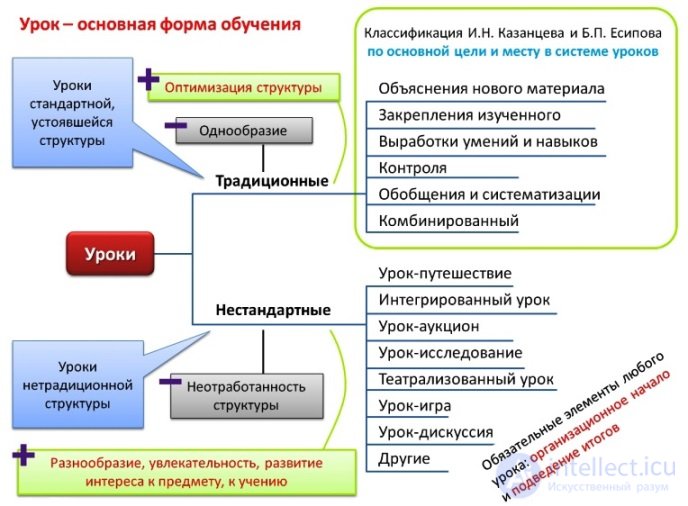
Fig. 4.10. Typology of lessons
To the top
The main forms of organization of educational and cognitive activity in the classroom
A variety of forms of education is one of the most important requirements for a modern lesson. In terms of student enrollment, frontal, individual and group forms of education are distinguished.
During frontal training, the teacher manages the activities of all the students at the same time working on the solution of a single educational task, organizing the cooperation of the students and determining the pace of work that is the same for all. Frontal forms allow you to conduct mass training, save lesson time, for example, when explaining, instructing, demonstrating, addressing them at once to all students. However, frontal work does not allow to take into account individual differences of students, applying frontal training, the teacher has to focus on the average student. As a result, weak students do not maintain the proposed mastering rate, and strong students are bored of idleness.
The disadvantages of front-end training in the classroom are compensated by individual forms of work. Individual learning is also an independent performance by students of the same tasks for the whole class (exercises, homework, independent and examinations, etc.) and the performance of tasks assigned to teachers by individual students, taking into account their educational opportunities. In the latter case, the training is called individualized. Individualization of training can be achieved, for example, with the help of specially designed cards with tasks of different levels of complexity, and different subjects. Individualization of training can be carried out both in class and in homework. In the case when some students work on the implementation of individual tasks, and some - with a teacher, the forms of organization are called individual-group.
The peculiarity of group forms of education is that the teacher controls the educational and cognitive activity of groups of students in the class. At the same time, pedagogical management is carried out not only directly, but also indirectly - through student leaders (commanders, foremen, team leaders). Training groups can be formed ...
- as a group of constant composition (link form);
- as temporary, formed specifically to perform a specific task (brigade form);
- as groups that perform their part of the work in general for several groups of the task (cooperative-group form);
- as groups that unite students with the same learning opportunities (group-differential form).
Group forms also include work in pairs.
To the top
Additional forms of organization of the educational process
Student homework
Homework allows students to more effectively consolidate knowledge, improve the skills and abilities obtained in the lesson, develop their independent work skills and prepare them for self-education, instill a sense of responsibility, develop accuracy, assiduity and other socially valuable qualities. The main fundamental difference between homework and classroom work is that it proceeds without the direct guidance of a teacher, albeit on his instructions. When doing homework, the student himself chooses the time and pace of assignments, he is deprived of the help of a teacher and the support of his comrades, there is no student team at home, which has a beneficial effect on creating a working mood, makes the work more interesting.
Based on the didactic goals, there are three types of homework:
- preparing for the perception of new material;
- aimed at consolidating knowledge, developing skills;
- requiring the use of acquired knowledge in practice (in this type of homework, a special group consists of tasks of a creative nature: writing essays, presentations, abstracts; drawing drawings, handicrafts, visual aids, etc.)
To the top
Overtime work on the subject
A class-based learning system has many advantages over others. But it, like any strictly regulated system, has a drawback: the monotony of forms, even if rational, tires students, often turns the teaching into boring routine work. Therefore, in addition to the lessons in school, extracurricular (auxiliary, non-obligatory for visiting) forms of organization of the pedagogical process are practiced, bringing to the organization of the cognitive activity of pupils much needed entertainment and diversity.
Among the extracurricular forms there are two large groups:
1) permanent (electives, clubs, sports clubs, interest clubs, etc.);
2) episodic (subject Olympiads, contests, exhibitions, quizzes, etc.).
Constantly operating forms of after-hour work are carried out as a system of occupations. Episodic - as single episodes of the pedagogical process.
Overtime work on any subject is an important component of the school educational process, significantly affecting the final result of training and education of schoolchildren. In the methodological literature, extracurricular work on the subject is considered as a strictly thought-out and comprehensively implemented system of educational and educational activities of various forms and content.
Overtime work is multifunctional. When properly carried out, it not only contributes to the deepening of knowledge and development of students' interest in the subject, but also has a nurturing effect on them, develops creative activity, helps the teacher to identify gifted children, to fully implement an individual and differentiated approach to learning.
Overtime work on the subject should be a logical continuation of the lesson in the sense that it, like the lesson, is an important link in the unified system of instruction provided by the teacher at school. When developing every extracurricular activity or lesson, the teacher must clearly understand his place in this system. But the most important thing in organizing extracurricular work on the subject is how to organize communication, how to interest schoolchildren, awaken and stimulate their imagination and initiative.
Psychological, pedagogical and methodical literature devoted to various issues of extracurricular educational and cognitive activity of schoolchildren notes its potential in shaping humanistic relationships among students, in enhancing cognitive activity, in arming self-development skills, and in developing creative abilities. Such a wide range of effective pedagogical interaction "teacher - student" outside the lesson is due to the unregulated nature of communication, allowing the teacher to create various situations of success for schoolchildren, that is, to give everyone the opportunity to express themselves in the most appropriate field of activity for him.
Among the principles of the organization of extracurricular work on the subject, in addition to general didactic, are the following principles:
- the relationship of extracurricular work with lessons;
- voluntary participation of schoolchildren in extracurricular activities;
- student initiative;
- entertaining in the content and forms of organization of extracurricular work;
- equality (that is, the provision of opportunities for participation in extracurricular work to students of different levels of learning).
These principles are interconnected, only their comprehensive compliance ensures success.
To the top
Types and training systems
The types of training are determined as a result of the separation of various educational processes on some basis. Different types of studies are highlighted in different scientific studies and pedagogical textbooks (Fig. 4.11).
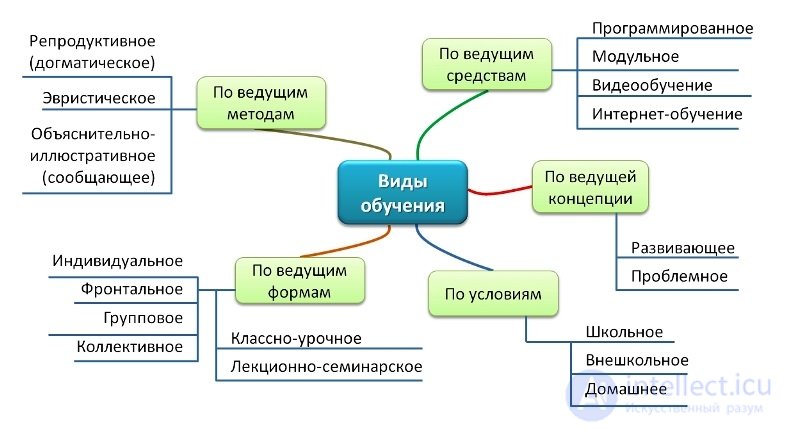
Fig. 4.11. Types of training
Consider some types of training.
The first type of systematic teaching in history was used by the ancient Greek philosopher Socrates and was called the Socratic conversation . The essence of the Socratic conversation is to find the truth by asking leading questions. The teacher-philosopher stimulated the student's cognitive interest with his questions and, arguing, led the student's thought along the path of knowledge. Socratic conversations were focused on individual training or work with a small group of students who initially showed an interest in knowledge.
The first type of organization of training for a large group of students — dogmatic training — was widely adopted in the Middle Ages. The purpose of such training is the assimilation of book knowledge, their acceptance as immutable truths ( dogma is a position taken on faith, recognized as indisputable without any evidence). The task of the students was to correctly reproduce ready-made truths. The main activities of the students were hearing and rote learning through repeated repetitions. The main teaching tools were religious books that were written in Latin (therefore, the training was usually also conducted in Latin). Dogmatic learning is characterized by the isolation of knowledge from life, the forms of learning from its content.
In the XVII century. in Europe, dogmatic explanatory teaching has replaced the dogmatic one. This type of training is based on the theory of sensationalism - knowledge through sensory perception (F. Bacon, J. Locke, etc.). The founder of explanatory and illustrative learning - Ya.A. Comenius.
продолжение следует...
Часть 1 Learning theory
Часть 2 - Learning theory
Часть 3 - Learning theory
Comments
To leave a comment
Pedagogy and didactics
Terms: Pedagogy and didactics